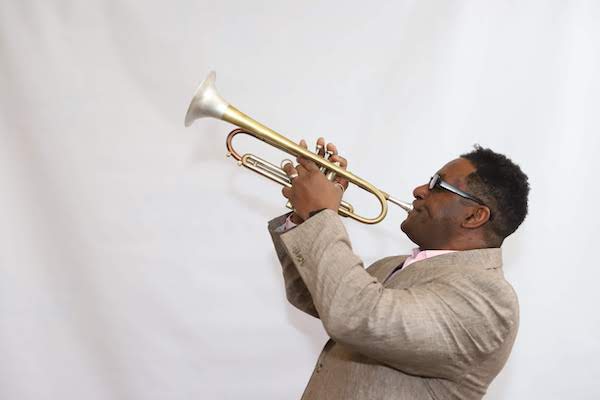Dec 9, 2025 12:28 PM
In Memoriam: Gordon Goodwin, 1954–2025
Gordon Goodwin, an award-winning saxophonist, pianist, bandleader, composer and arranger, died Dec. 8 in Los Angeles.…

“I express my emotions better musically than socially most of the time,” Marcus Printup said.
(Photo: Adam McCullough)The young musicians—Miles Lennox (keyboard), Hannah Marks (bass) and T.J. Reddick (drums)—demonstrated great maturity as they dispatched a set of guileless Printup originals filled with simple but artful melodies and subtle but swinging propulsion. Some had themes harking back to the trumpeter’s own youth. Among them: “Hopscotch,” from 2014’s Lost (SteepleChase), an upbeat recollection of active afternoons in the Printups’ backyard, and “The Bishop,” from 2015’s Young Bloods (SteepleChase), a reverential remembrance of a mentor, the late Bishop David Hudson.
Printup said he used young musicians in part because “they have something different, something that inspires me to play.” And play he did. In the JLCO, which occupies him for nearly 10 months a year, a musician rarely is assigned more than one or two solos a night. But in the context of a quartet, he had the luxury of extending improvisations and stretching forms.
Gigs like the one in Newark allow him to give young musicians a taste of the trial-by-fire apprenticeship experience that he mostly missed out on, save for working with the players from Duke Ellington’s band who still populated the Lincoln Center orchestra when he arrived.
“Coming up in the 1990s,” he said, “I never got to play with many older musicians, except for in the orchestra.”
Meeting young musicians, Printup’s reticence fades and he liberally dispenses advice. In a nutshell: “I try to get the kids to go inside themselves, not just play the notes.” Those words are as relevant to high school kids (in JALC’s Essentially Ellington band competition, with which he has a long association) as to college students (at Montclair State University, where he recently joined the faculty).
Bassist Marks, who at 22 was the oldest of the three musicians at the Newark gig, said she had valued Printup’s words ever since he discovered her last year at the Betty Carter Jazz Ahead educational residency, with which he has been involved since meeting the late singer with Marsalis at a 1993 jam session.
“That was my banner year,” he said.
That year, during a performance at the inaugural Jazz Ahead program in the Brooklyn Academy of Music, Printup, backing Carter on “The Nearness Of You,” discovered the value of restraint. Near the tune’s end, he added a coda to her final flourish, topping her high note with an even higher one. She was not amused.
“I learned my lesson,” he said. “Even though I thought that would be musical, and I had the utmost respect for her, I think to her it seemed like I was trying to outdo her. I learned that when you play with a vocalist, you are the accompaniment.”
Also in ’93, he marked his Lincoln Center debut with a man he described in a recent email as “the most influential person/friend to light that spark in me”—pianist Marcus Roberts, whose epic suite Romance, Swing And The Blues was having its premiere. It was revived two decades later, with Printup again on board.
The piece, Roberts said, “had abstract thematic elements but also could be expressed through various approaches to blues playing.” He added, “Marcus has a really, really special connection with the blues. His playing has intensity. It sounds like somebody who really enjoys life, developing as a man and as a musician.”
Roberts and Printup first met in 1991, when the pianist noticed the trumpeter in the band at the University of North Florida, where he was studying when he won the International Trumpet Guild Jazz Trumpet Competition.
The meeting, Printup said, marked a turning point: “Everything started for me. Marcus taught me how to put my upbringing into my music. Before Marcus, I played things straight. He said, ‘Where are you from, Georgia? Did your parents raise you in the church?’ I said, ‘Yup.’ He went, ‘How did your mama sing?’ I started singing something. He started singing something and told me how I could incorporate that voice into my horn.”
Soon, Printup was on the road with Roberts (who has been blind since age 5), doubling as his tour manager for a year-and-a-half: “I just wanted to hang around him. I would take care of his money, help him get dressed and everything. Marcus would give me lessons every night after the gig.”

Goodwin was one of the most acclaimed, successful and influential jazz musicians of his generation.
Dec 9, 2025 12:28 PM
Gordon Goodwin, an award-winning saxophonist, pianist, bandleader, composer and arranger, died Dec. 8 in Los Angeles.…

Nov 13, 2025 10:00 AM
For results of DownBeat’s 90th Annual Readers Poll, complete with feature articles from our December 2025 issue,…

Flea has returned to his first instrument — the trumpet — and assembled a dream band of jazz musicians to record a new album.
Dec 2, 2025 2:01 AM
After a nearly five-decade career as one of his generation’s defining rock bassists, Flea has returned to his first…

“It’s a pleasure and an honor to interpret the music of Oscar Peterson in his native city,” said Jim Doxas in regard to celebrating the Canadian legend. “He traveled the world, but never forgot Montreal.”
Nov 18, 2025 12:16 PM
In the pantheon of jazz luminaries, few shine as brightly, or swing as hard, as Oscar Peterson. A century ago, a…

Dec 11, 2025 11:00 AM
DownBeat presents a complete list of the 4-, 4½- and 5-star albums from 2025 in one convenient package. It’s a great…